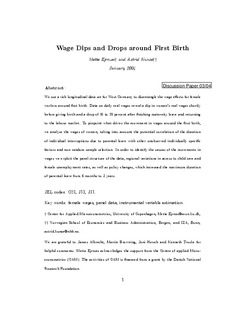Wage dips and drops around first birth
Working paper
Permanent lenke
http://hdl.handle.net/11250/162868Utgivelsesdato
2004-01Metadata
Vis full innførselSamlinger
- Discussion papers (SAM) [657]
Sammendrag
We use a rich longitudinal data set for West Germany to disentangle the wage effects for female
workers around first birth. Data on daily real wages reveal a dip in women’s real wages shortly
before giving birth and a drop of 10 to 20 percent after finishing maternity leave and returning
to the labour market. To pinpoint what drives the movement in wages around the first birth,
we analyse the wages of women, taking into account the potential correlation of the duration
of individual interruptions due to parental leave with other unobserved individually specific
factors and non random sample selection. In order to identify the causes of the movements in
wages we exploit the panel structure of the data, regional variations in access to child care and
female unemployment rates, as well as policy changes, which increased the maximum duration of parental leave from 6 months to 3 years.
Utgiver
Norwegian School of Economics and Business Administration. Department of EconomicsSerie
Discussion paper2004:3
